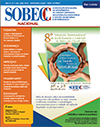Surgical Positioning of clients undergoing hip surgery: adverse events
Keywords:
Patieni positioning, Surgery, Orthopedics, lntraoperative complications.Abstract
This study aims to identify the adverse events resulting from surgical positioning of patients submitted to hip surgery. It is a work of scientific literature review, composed by on-line studies at liealtli databases arca. using for searclies the kevwords iii health sciences. Theresults indicated the following adverse events reported in studies: hypotension, paresis, paresthesia. paraplegy, reductional transcutaneous oxygen levels lowerthan 20 mm Hg: compartment syndromeand rhabdomvolysis. E concludes that,perioperative teani musi dispose of strategies. using basic science knowledge such as anatomy and pliysiolog, as dl as the technological resources, in order that canensure customer safety during surgical anesthesia period.References
Potter PA, Perry AG. Fundamentos de enfermagem. 5 ed. Rio de Janeiro: Guanabara Koogan: 2004.
Barash PG, CulIen BF, Stoeitíng RK. Tratado de anestesiologia clínica. São Paulo: Manoie: 1993.
Meidrum R. Lipscomh P. Compartment syndrome ofthe leg after Iess than 4 hours of elevation on a fracture tablcSouth Med J. 2002;95(2):269-71
Dugdale TW, Schutzer SF, Deafenbaugh MK, Bartosh RA. Compartment syndrome complicating use ofthe hemilithotorny position during femoral nauing: a report oftwo cases. J Bone Joint Surg Am. 1989;71(10):1556-7.
Capela CF, Guimarães SM. Posicionamento cirúrgico e as complicações transoperatórias: recomendações de cuidados intra-operatórios. Rev SOBECC. 2009;14(1):51-61.
Lachiewicz PF, Latimer HA. Rhandornyolysis following total hip arthroplasty. 1 Bone Joint Surg. 2001 :73b(4):576-9.
Schwartsmann CR, Oliveira GK, Ramires LC, Nery PC, Gonçalves AG, Oliveira RK, et al. Lesão do plexo braquial após artroplastia total do quadril: relato de caso. Rev Bras Ortop. 1998;33(1):76-8.
Trillo L. Samsó E. Peripheral nerve lesions in the postoperative period. Rev Esp Anestesiol Reanim. 1992;39(6):381-5.
Russell GV Jr, Nork SE, Chip Routi ML Jr. Perioperative complications associated with operative treatment of acetabular fractures. 1 Trauma 2001;5l(6):1098 -103.
Danish SE, Wilden IA, Schuster J. latrogenic paraplegia in 2 morbidly obese patients with ankylosing spondylitis undergoing total hip arthroplasty. J Neurosurg Spine. 2008;8(1):80-3. II. Versluysen M. Pressure sores in e!- derly patients: the epidemiology related to hip operations. 1 Bone ioint Surg Br. 1985,67(1):10-3.
Hughes AW. Prevention of pressure sores in patients with fractures of the femoral neck. Injury. 1986; 17(1):19-22.
Ursi ES, Galvão CM. Prevenção de lesões de pele no perioperatório: revisão integrativa da literatura. Rev Lat Am Enferrn. 2006-,14(1):124-3 1.
Satisha M. Evans R. Venocaval compression due to abdominal post support and positioning during orthopaedic anacsthesia. Anaesthesia. 2007;62(10):1080- 1.
I5. Girgis Y, Dunlop W. Venocaval compression due to au abdominal post support. Anaesthesia. 2008:63(3):3 19- 20.
Bader DL, White SH. The viability of soft tissues iii elderly suhjects undergoing hip surgery. Age Ageing, 1998;27(2):217-2 1.
Association of PeriOperative Registered Nurses. Recommended practices for positioning the patient in the perioperative practice Setting. AORN J [!nternet. 2001 [cited 2008 Dec 71;73(1):231-8. Available from: http:// findarticles.com/p/articles!mimOFSL/ is 173/ai 70361341/
Florio MCS, Galvão CM. Cirurgia ambulatorial: identificação dos diagnósticos de enfermagem no período perioperatório. Rev Lat Am Eníerm. 2003;l 1(5):630-7.
Carpenito-Moyet U. Manual de diagnósticos de enfermagem. 10 ed. Porto Alegre: Artmed; 2006
Sociedade Brasileira de Enfermeiros de Centro Cirúrgico, Recuperação Anestésica e Centro de Material e Esterilização. Práticas recomendadas - SOBECC. 5 cd. São Paulo: SOBECC; 2009.
Downloads
Published
How to Cite
Issue
Section
License
By publishing in Revista SOBECC, authors retain the copyright of their article and agree to license their work using a Creative Commons Attribution (CC BY 4.0) International Public License, thus accepting the terms of this license. The CC BY 4.0 license allows others to distribute, remix, adapt, and create from the published article, even for commercial purposes, provided they give due credit to the creators of the work (authors of the article).
The authors grant to Revista SOBECC the right of first publication, to identify itself as the original publisher, and grant to the journal a non-exclusive license to use the work in the following ways: (1) to sell and/or distribute the article in hard copies and/or in electronic format; (2) to distribute parts and/or the entire article in order to promote the journal through the internet and other digital and printed media; (3) to record and reproduce the article in any format, including digital media.
With this license, authors can enter into separate contracts for non-exclusive distribution of the article (e.g., publishing in an institutional repository or as a book chapter), with acknowledgement of authorship and initial publication in Revista SOBECC. Authors are encouraged to publish and distribute their work online after publication in the Revista SOBECC, as this can increase the article's visibility and impact.
In line with the journal's policies, each published article will be assigned a CC BY 4.0 license, which will be visible on the abstract page and in the PDF of each article with the respective link to the license terms.











